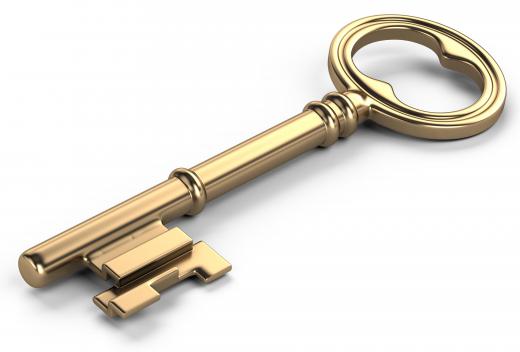Two types of keys are referred to as skeleton keys. The first is the classic key design that fits a warded lock, which has been in use for approximately two thousand years. The second is a master key, a key designed to fit in a wide variety of locks. Antique skeleton keys are not in wide use except on old homes and antique furniture, but master keys are a part of daily life for many people such as locksmiths or people who have homes or businesses with a number of locking doors or devices.
An antique skeleton key classically has a long shaft, a simple bit, and an ornately decorated bow. The bow is the section which is held by the person inserting it. Many old fashioned skeleton keys were made during an era when elaborate metalwork was prized, so the bow may have decorations and ornamental flourishes to make it more distinctive. The bit is the section of a key which is actually inserted into the door, and in the case of a skeleton key, the bit is very simple, and able to open a large number of doors with locks which are similar enough for the key to work.

Originally, these keys were paired with a warded lock. A warded lock uses a set of plates inside the lock which face outwards, rather than running parallel to the side of the key, as is the case with modern keys. A key which fit a warded lock would fit between these plates, and the top of the key would fit into a depression designed to hold it in place while the key was turned, forcing the wards aside and opening the lock. These locks were designed centuries ago, and were widely used until the early twentieth century, when more secure locks were devised. To obtain a skeleton key, consumers can search antique stores or have one custom made by a company which supplies antique keys.

Because of the adaptability of the skeleton key, the term was also adopted to refer to a passkey or master key. A master key is capable of opening any lock within a set family of locks or location. For example, many drivers have a master key which can work in the ignition and open all of the car doors along with the trunk and gas cap, as compared to a valet key, which only operates the ignition and driver's side door. In another common instance, a business may have a number of locking doors which can all be unlocked with a master key, but actually have separate locks, allowing the business to give people keys to offices and bathrooms which are not effective throughout the business. Many hotels also use this technique, giving maids a passkey to the rooms, but guests individual keys for their rooms.
Ever since she began contributing to the site several years ago, Mary has embraced the exciting challenge of being a About Mechanics researcher and writer. Mary has a liberal arts degree from Goddard College and spends her free time reading, cooking, and exploring the great outdoors.

